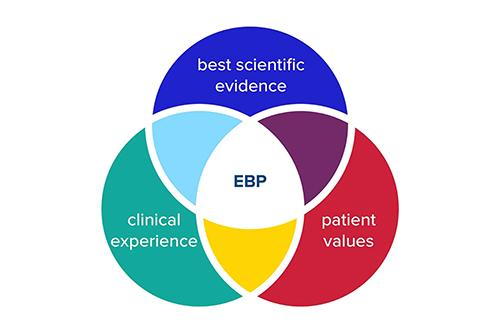
Understanding Evidence-Based Practice (EBP) in Chiropractic and Healthcare
Introduction:
Evidence-Based Practice (EBP) is a systematic and scientific approach to healthcare that involves making clinical decisions based on the best available evidence. It is a crucial aspect of modern healthcare that helps providers deliver high-quality, effective patient care. It is a process that involves the use of current, relevant, and reliable research evidence to inform clinical practice and decision-making. EBP aims to ensure that healthcare providers provide the highest quality of patient care based on the best available evidence.
What is Evidence-Based Practice?
EBP is a clinical decision-making process that combines clinical expertise with the best available evidence to provide the most effective care to patients. This approach considers the best scientific evidence, the individual patient’s needs and preferences, and the clinical expertise of the healthcare provider.
EBP helps healthcare providers, including chiropractors, to make informed decisions about patient care by incorporating the best available evidence into the decision-making process. Integrating patients’ preferences and clinicians’ experiences with scientific Evidence yields the best outcome.
Using EBP requires abandoning outdated and debunked science, examination methods, and care delivery practices. Instead, EBP requires choosing effective and scientifically validated procedures to meet individual patient needs.
Why is Evidence-Based Practice important?
EBP is essential for several reasons. First, it helps healthcare providers provide patients with quality care based on the best available information. This helps minimize the risk of harm and ensures that patients receive the most effective treatments. Second, EBP helps healthcare providers to stay up-to-date with the latest advancements in their field and to make informed decisions about patient care. Third, EBP helps to promote a culture of continuous improvement within the healthcare industry by encouraging healthcare providers to critically evaluate their practices and make changes as needed based on the best available evidence.
Lastly, it helps healthcare providers avoid pitfalls of Logical Fallacies and Cognitive Biases that may interfere with appropriate patent care and even occasionally interfere with their respective field advancement.
How does Evidence-Based Practice work?
The process of Evidence-Based Practice involves several key steps. According to the Cleveland Clinic, the “five A’s of EBP” in health science are:
- Ask: Identification of a clinical question or problem. Formulate searchable clinical questions about a patient, problem, intervention, or outcome.
- Acquire: Search reputable resources for relatable Evidence to answer the questions.
- Appraise: Critical appraisal of literature and the answers and determine whether or not the Evidence is high-quality and valuable.
- Apply: Make clinical decisions by implementing the best available evidence, practitioner experiences, and patient preferences.
- Assess: Evaluate the outcome of applying the Evidence to the patient’s condition.
It is important to note that EBP is not a one-time process but a continuous cycle of asking clinical questions, searching for evidence, and applying the results to patient care. This helps ensure that healthcare providers use the most up-to-date and accurate information to deliver the best possible care to their patients.
How Evidence-Based Practice (EBP) benefit chiropractors and improve patient outcomes?
Evidence-Based Practice (EBP) can significantly benefit all healthcare practitioners, such as chiropractors, by providing a systematic approach to clinical decision-making and improving patient outcomes. By using EBP, chiropractors can make informed decisions about patient care and choose treatments that have been shown to be effective through rigorous research evidence. This leads to improved patient outcomes and a higher level of patient satisfaction. EBP also helps chiropractors minimize the risk of harm to patients by avoiding treatments that have been shown to be ineffective or harmful.
Staying up-to-date with the latest advancements in their field is also made easier with EBP, as it helps chiropractors incorporate new research evidence into their practice as it becomes available. This enables chiropractors to provide their patients with the most effective treatments available and build trust and confidence in their care by providing a systematic approach to clinical decision-making.
Types of research and hierarchy of evidence used in EBP
According to the information’s credibility, there are at least four Levels of Evidence in healthcare research. From the most credible to the least, they include:
- Systematic review or meta-analysis of all relevant RCTs (randomized controlled trials)
- Randomized controlled trials
- Cohort studies, case-control studies, observational studies
- Expert opinions supported by their documented experience, studies, or reports
Benefits of Evidence-Based Practice
There are several benefits to using EBP in healthcare. Some of the key benefits include:
- Improving patient outcomes: By using the best available evidence to make clinical decisions, healthcare providers can deliver more effective care, leading to improved patient outcomes.
- Reducing healthcare costs: EBP can help to reduce healthcare costs by ensuring that treatments and procedures are effective and appropriate for each patient.
- Encouraging continuous learning: The EBP process involves continuous learning and improvement, which helps healthcare providers to stay up-to-date with the latest advances in healthcare.
FAQs
What is the goal of Evidence-Based Practice?
The goal is to provide the best possible outcomes for patients based on the best available evidence. It is a systematic and scientifically grounded approach to healthcare decision-making that aims to minimize the risk of harm to patients and ensure that patients receive the most effective treatments available.
How does Evidence-Based Practice help healthcare providers?
EBP helps healthcare providers to make informed decisions about patient care by incorporating the best available evidence into the decision-making process. This leads to improved patient outcomes and helps ensure that healthcare providers provide the highest quality of care possible.
Is Evidence-Based Practice only for healthcare providers?
No, Evidence-Based Practice is not only for healthcare providers. Patients can also benefit from EBP, as it helps ensure that they receive the most effective treatments based on the best available evidence.
Conclusion
Evidence-Based Practice is a crucial aspect of modern healthcare that helps providers deliver high-quality, effective patient care. By combining clinical expertise with the best available evidence, EBP ensures that clinical decisions are based on the most up-to-date and accurate information available. Whether in a hospital, chiropractic clinic, or primary care practice, EBP is an essential tool for improving patient outcomes and reducing healthcare costs.
